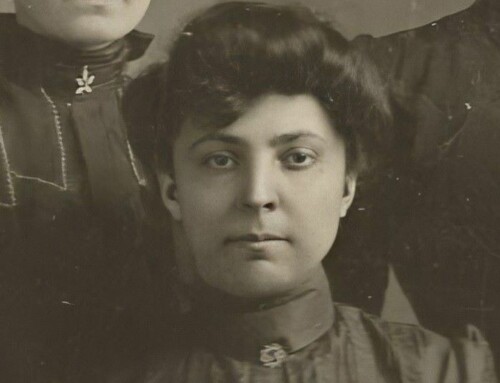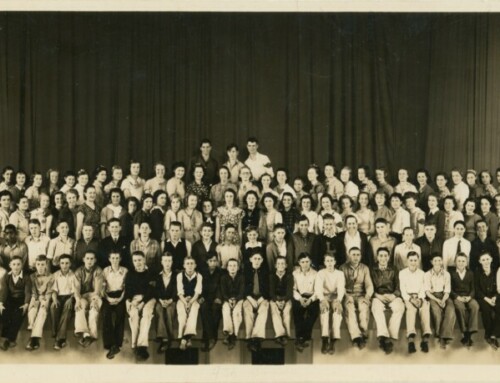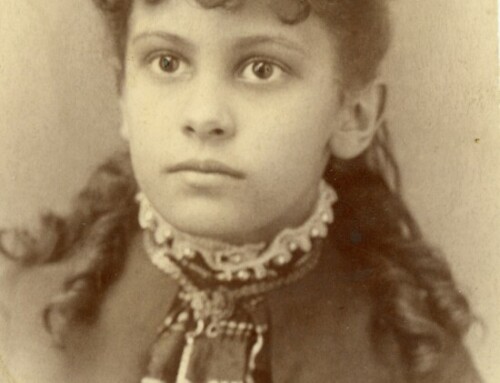It began with a simple home improvement project adding insulation to a bedroom closet wall to improve energy efficiency in an old 1920s farmhouse. Once the plaster and lathe had been removed, the homeowners found a few historic surprises waiting for them. Artifacts that would lead to an interesting hunt through history.
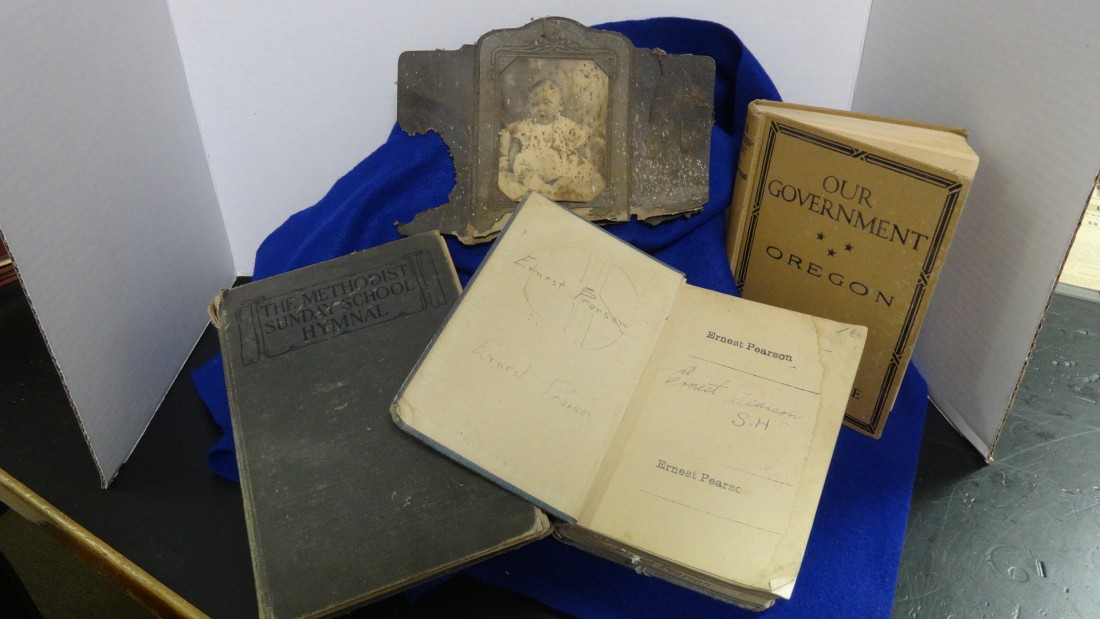
Pearson and Coon family artifacts found in the closet wall. Photo Credit: Kaylyn Mabey of the Willamette Heritage Center
The first item, a Methodist hymnal with a clue penciled inside the front cover, Hope Chapel Sunday School. The second, the book Our Government – Oregon, a high school civics textbook with several notations written within, including the name Ruth Pearson. The third, another high school textbook, Modern Algebra – Second Course, which clearly belonged to Ernest Pearson given the fact that his name appeared five times in the front cover. And the last artifact, a fragile photograph of a baby with the inscription Donald Raoul Coon, age 3 months, weight 13 lbs. 5 oz. Could the items and their owners be connected with the property in some way? Only time and research would tell.
The farmhouse and its property are located in a rural area in southern Marion County so we turned first to historic maps, working our way backward through time and land development. The property was initially developed by the Oregon Land Company organized by prominent Quaker Dr. Henry J. Minthorn. From a 1912 Ladd and Bush quarterly magazine we learn that during the late 1890s five thousand acres of land was planted in Italian prunes by the company, subdivided into ten-acre tracts, and then sold to investors at $125 per acre with the Land Company agreeing to “cultivate, spray, prune and otherwise care for” the orchards until the trees were four years old. The property in question was purchased by two Quaker brothers from Indiana, Eber and David Pearson. Eber moved on rather quickly to new prospects in Montana but David and his small family stuck around and held onto the property for generations to come, later diversifying to apples, berries, cherries, and pears. Enough produce to supply a grocery store in town owned by Harry, one of David’s sons.
When David and his family moved onto the property in 1900 he was married to his second wife Sarah Allen and raising three children from his first marriage: Shurl, Hurl, and Harry. A daughter Murl had died in infancy. David and Sarah would eventually add four more children to their family: Cecil, Gerald, Ernest, and Ena. In the 1920 census we find three Pearson households living on the property. Parents David and Sarah with three sons including five-year-old Ernest. Son Hurl and his wife Mary with two children. And son Harry with his wife Gladys and a two-year-old daughter named Ruth. Could these two youngsters be the future owners of the high school textbooks found in the wall?
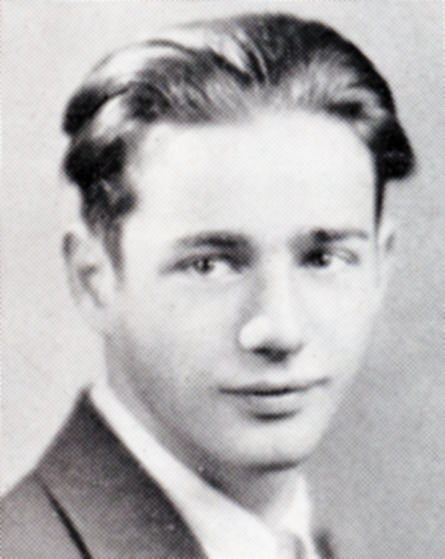
Senior class photo of Salem High graduate Ernest Pearson. Photo Credit: Salem High School Clarion 1931, WHC 82.43.3.1
Only two years apart, Ernest and Ruth were technically step-uncle and niece, but growing up in such close proximity one could easily surmise that they were raised more as cousins and friends. The farmhouse where the books were found, was built in 1922 according to the Marion County Assessor’s office and land records indicate that it was occupied by the David S. Pearson family. Perhaps the bedroom itself had been occupied by Ernest.
The Depression years of the 1930s brought challenges for the Pearson families and Harry moved his family to Eugene for a job in the grocery business. While Ruth attended high school in Eugene, Ernest attended Salem High School, graduating in 1931. He would go on to attend Pacific College, now George Fox University where he met and married his wife Alice Kivett in 1935. That same year after his father David passed away, the couple moved home to manage the family farm until Harry and family moved back, leaving newly-married Ruth behind in Eugene. Harry would go on to open a grocery store in Salem supplied by the family farm. Once relieved of farm responsibilities, Ernest was free to resume his education. He would graduate from Oregon State College in 1950 with a bachelor’s degree in forestry and become instrumental afterward spear-heading efforts and supervising work parties to replant the Tillamook Burn area.
Now that we’ve connected the Pearson family and property with the textbooks, let’s turn our attention to the Methodist hymnal. Cemetery and church records reveal that the Pearson’s were a prominent Quaker family in the area. Prior to the building of the first Friends Church, the congregation was allowed to meet in the local Methodist church, Hope Chapel. A perusal of historic newspapers reveals a few more clues about Ernest and Ruth’s musical talents for singing and playing the piano and organ. These talents were often used for the benefit of varied congregations and social groups in the area. Perhaps the hymnal was a souvenir from the building or put to use in developing their repertoire.
All that remains on our historic hunt is the baby picture. Who was little Donald Raoul Coon and what is his connection to the Pearson family? Online genealogical database Ancestry gives us a framework of information to work with in our search. We learn that Donald was born in 1928 to Elton and Mildred Coon of Salem. The family lived in Salem not far from the Valley Motor Company on Mission Street where Elton worked as a mechanic. Thankfully online newspapers provide a few more clues to help us connect the dots. Through a series of local columns we learn that Mildred Coon’s sister is a neighbor of the Pearson family. And through this connection the families become friends, often celebrating Christmas and family dinners together. A small collection of items, hidden in the wall of a closet. A time capsule of sorts for the Pearson family.
This article was written by Kaylyn F. Mabey for the Statesman Journal where it was printed on 21 August 2016. It is reproduced here for reference purposes.
References:
- 1878 Marion-Linn Counties Historical Atlas Map p. 40
- Marion County Metsker Maps – 1929, 1941, 1971
- Marion County Assessor’s website
- Polk’s SALEM and Marion County Directories 1928-29
- Ladd & Bush Quarterly 1912
- Ernest Pearson death notification, Oregon Statesman (Salem, OR), 8 Dec 1950 p. 17
- Harry Pearson death notification, Daily Capital Journal (Salem, OR), 6 Aug 1935 p. 12
- South Salem Friends church announcement, Daily Capital Journal (Salem, OR), 12 July 1946 p. 12
- Ernest Pearson – Nellie Simpson wedding announcement, Oregon Statesman (Salem, OR), 22 Sep 1937 p. 6
- Pearson baby announcement, Oregon Statesman (Salem, OR), 25 Feb 1936 p. 5
- “Older Folks Honor Rosedale Woman” Oregon Statesman (Salem, OR), 14 Jun 1935 p. 3
- “Young People’s Day at Rosedale with Installation” Oregon Statesman (Salem, OR), 26 Aug 1933 p. 6
- “Rosedale Friends Endeavors Elect” Daily Capital Journal (Salem, OR), 30 Aug 1933 p. 2
- “Institute People Conduct Services” Oregon Statesman (Salem, OR), 10 Apr 1928 p. 2
- Ernest Pearson – 8th grade graduation announcement, Oregon Statesman (Salem, OR), 17 Jun 1925 p. 3
- “Eugenics Contest Good” Daily Capital Journal (Salem, OR), 29 Jun 1914 p. 2
- “Salem High School Senior Thespians” Oregon Statesman (Salem, OR), 17 Apr 1931
- “Sunnyside Petitions for New County Road” Daily Capital Journal (Salem, OR), 20 Dec 1922 p. 4




